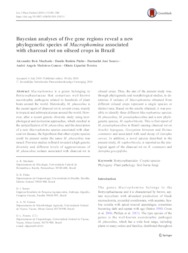Bayesian analyses of five gene regions reveal a new phylogenetic species of Macrophomina associated with charcoal rot on oilseed crops in Brazil.
Bayesian analyses of five gene regions reveal a new phylogenetic species of Macrophomina associated with charcoal rot on oilseed crops in Brazil.
Autoria: MACHADO, A. R.; PINHO, D. B.; SOARES, D. J.; GOMES, A. A. M.; PEREIRA, O. L.
Resumo: Macrophomina is a genus belonging to Botryosphaeriaceae that comprises well-known necrotrophic pathogens related to hundreds of plant hosts around the world. Historically, M. phaseolina is the causal agent of charcoal rot in several crops, mainly in tropical and subtropical areas around the world. However, after a recent genetic diversity study using morphological and molecular approaches, which resulted in the epitypification of M. phaseolina, and the description of a new Macrophomina species associated with charcoal rot disease, the hypothesis that other cryptic species could be present under the name M. phaseolina was raised. Previous studies in Brazil revealed a high genetic diversity and different levels of aggressiveness of M. phaseolina isolates associated with charcoal rot in oilseed crops. Thus, the aim of the present study was, through phylogenetic and morphological studies, to determine if isolates of Macrophomina obtained from different oilseed crops represent a single species or distinct taxa. Based on the results obtained, it was possible to identify three different Macrophomina species: M. phaseolina, M. pseudophaseolina and a new phylogenetic species, M. euphorbiicola. This is first report of M. pseudophaseolina in Brazil causing charcoal rot on Arachis hypogaea, Gossypium hirsutum and Ricinus communis and associated with seed decay of Jatropha curcas. In addition, a novel species described in the present study, M. euphorbiicola, is reported as the etiological agent of the charcoal rot on R. communis and Jatropha gossypifolia.
Ano de publicação: 2019
Tipo de publicação: Artigo de periódico
Unidade: Embrapa Algodão
Palavras-chave: Botryosphaeriales, Cryptic species, Phylogeny, Plant pathology, Soil-borne fungi
Observações
1 - Por padrão são exibidas publicações dos últimos 20 anos. Para encontrar publicações mais antigas, configure o filtro ano de publicação, colocando o ano a partir do qual você deseja encontrar publicações. O filtro está na coluna da esquerda na busca acima.
2 - Para ler algumas publicações da Embrapa (apenas as que estão em formato ePub), é necessário ter, no celular ou computador, um desses softwares gratuitos. Sistemas Android: Google Play Livros; IOS: iBooks; Windows e Linux: software Calibre.
Acesse outras publicações
Acesse a Base de Dados da Pesquisa Agropecuária (BDPA) para consultar o acervo completo das bibliotecas da Embrapa.

